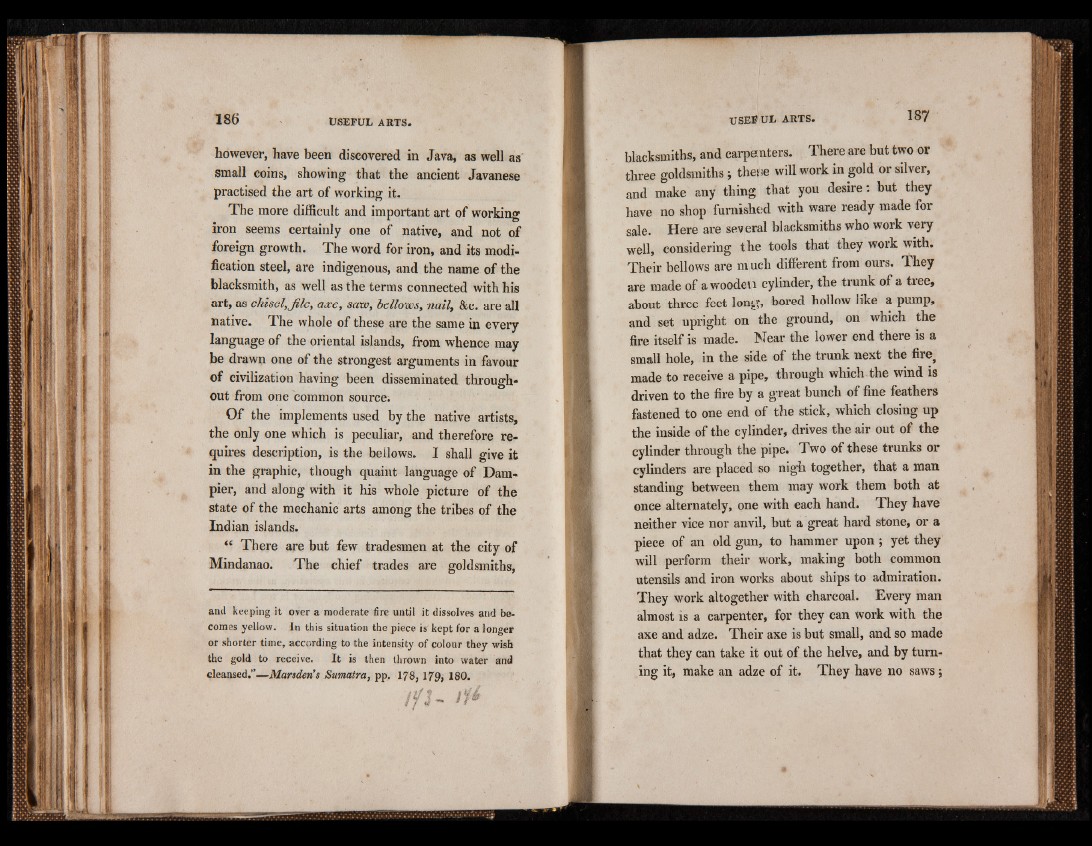
however, have been discovered in Java, as well as
small coins, showing that the ancient Javanese
practised the art of working it.
The more difficult and important art of working
iron seems certainly one of native, and not of
foreign growth. The word for iron, and its modification
steel, are indigenous, and the name of the
blacksmith, as well as the terms connected with his
art, as chisel, file, axe, saw, bellows, nail, he. are all
native. The whole of these are the same in every
language of the oriental islands, from whence may
be drawn one of the strongest arguments in favour
of civilization having been disseminated throughout
from one common source;
Of the implements used by the native artists,
the only one which is peculiar, and therefore requires
description, is the beilows. I shall give it
in the graphic, though quaint language of Dam-
pier, and along with it his whole picture of the
state of the mechanic arts among the tribes of the
Indian islands.
“ There are but few tradesmen at the city of
Mindanao. The chief trades are goldsmiths,
and keeping it over a moderate fire until it dissolves and becomes
yellow. In this situation the piece is kept for a longer
or shorter time, according to the intensity of colour they wish
the gold to receive. I t is then thrown into water and
cleansed.”—Marsdens Sumatra, pp. 178, 179, 180.
blacksmiths, and carpenters. There are but two or
three goldsmiths; thesse will work in gold or silver,
and make any thing that you desire: but they
have no shop furnished with ware ready made for
sale. Here are several blacksmiths who work very
well, considering the tools that they work with.
Their bellows are m uch different from ours. They
are made of a wooden cylinder, the trunk of a tree,
about three feet long, bored hollow like a pump,
and set upright on the ground, on which the
fire itself is made. Near the lower end there is a
small hole, in the side of the trunk next the fire,
made to receive a pipe, through which the wind is
driven to the fire by a great bunch of fine feathers
fastened to one end of the stick, which closing up
the inside of the cylinder, drives the air out of the
cylinder through the pipe. Two of these trunks or
cylinders are placed so nigh, together, that a man
standing between them may work them both at
once alternately, one with each hand. They have
neither vice nor anvil, but a great hard stone, or a
piece of an old gun, to hammer upon; yet they
will perform their work, making both common
utensils and iron works about ships to admiration.
They work altogether with charcoal. Every man
almost is a carpenter, for they can Work with the
axe and adze. Their axe is but small, and so made
that they can take it out of the helve, and by turning
it, make an adze of it. They have no saws;